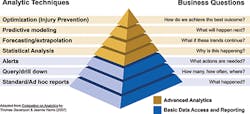The Holy Grail Of Safety: A Single, All-Encompassing Safety Leading Indicator
I have good and bad news on the topic of leading indicators for safety. First, the bad news: A single, all-encompassing safety leading indicator is like the fountain of youth – it probably does not exist. However, there is some good news: There is a single leading indicator that seems to stand above all the rest with regard to its ability to explain and predict workplace injuries. This leading indicator is the information that is derived from conducting safety inspections and observations.
A research study conducted in partnership with a team from Carnegie Mellon University (CMU) found that 75 percent of the variation in the frequency of safety incidents can be explained by the information derived from safety inspections and observations. Further, this team was able to build a computer model that could predict future incidents with accuracy rates as high as 80 to 97 percent.
How’d they do this? You guessed it: using inspection and observation data.
So, is your organization using this powerful leading indicator that can explain 75 percent of incidents and even predict them by as much as 97 percent of the time? If not, why not?
How Was this Research Conducted?
The team that conducted the research is part of an internal department at CMU that is on the cutting edge of machine learning and data analytics. This same department helped IBM build both the Deep Blue super-computer that beat the top chess masters in the 1990s, as well as the Watson super-computer that beat the top contestants on the game show "Jeopardy" just a few years ago.
The team was given access to four years of real-world safety-inspection and observation data from several different companies. They matched this data with the safety-incident data from these same companies across this same time period. Then, they fed a portion of both data sets to high-powered computers. These sophisticated machines "learned" by examining this big data that included millions of inspections, observations and incidents.
After a period of "learning," the systems derived several predictive models that used 90 days of safety inspections and observations to predict the safety incidents over the next 30 days. These models were then tested for accuracy against a data set that the computers had not yet seen. The best models proved to be accurate at predicting overall incident levels 80 to 97 percent of the time.
When these predictions were compared to the actual incidents, the R2 correlation was 0.75. An R2 of 0.75 may be interpreted as follows: 75 percent of the variation in the response variable (safety incidents) can be explained by the explanatory variables (safety inspections and observations).
From this analysis, it was determined that safety inspections and observations can explain and even predict safety incidents with dramatic accuracy and thus, are one of the most compelling safety leading indicators available today.
How Can Safety Inspection Data Be So Powerful?
How can inspection and observation data be so predictive? What about other leading indicators such as training, process controls and even culture?
Safety inspections and observations are so powerful because they are both a direct and indirect view into the myriad factors that affect workplace safety such as training, process controls and culture.
But further, inspections and observations also indirectly can measure other risk drivers like training and culture. For instance, if during an inspection an employee is found not following the proper fall protection procedures, a quick conversation with that employee can determine why. The employee might respond by saying, "I had no idea we had such procedures … this is my first week on the job!" This probably would suggest a new-hire training issue that needs to be addressed. However, if the employee responds with, “I’ve been doing this work this way for 20 years and have never been hurt,” then probably there is a cultural issue that needs to be addressed.
Regardless, when done properly, observations of the conditions on the worksite and the behaviors of employees within those conditions can provide information about both the direct and indirect causes of future safety incidents. The Carnegie Mellon University team’s analysis proved this, and savvy safety professionals intuitively have believed this for decades.
Like any system analysis, it is important to review the inputs of the process in order to understand – and even predict – the outputs. Safety observations and inspections give us insight into the inputs so that we can explain the outputs. In this case, the outputs are occurrence of safety incidents – or better yet, the lack-thereof.
How Can This Be Applied in the Real World?
While helpful, it’s not necessary to have a team of world-class data scientists and machine-learning experts at your disposal to make use of inspection and observation data. Much of the team’s work simply has confirmed what many safety folks have been professing for years: Safety inspections and observations are a critical component to operating a world-class safety function.
In fact, just the process of systematically and regularly conducting safety inspections and observations can yield better safety outcomes, especially if employees are engaged during the process by discussing the safe and unsafe observations that are found. The researchers concluded that the safest jobsites often involved non-safety personnel in the inspection process. If you can involve operations employees in your process, you can instill a focus and perspective on safety that goes outside just the safety functional group.
Making Use of a Powerful Leading Indicator
If your safety data set is not too large, basic data analytics can be used to answer basic business questions using standard software systems like Microsoft Excel. However, if your data set is large – or if you are trying to answer more strategic business questions like “where and when will my next safety incident occur?” – more advanced analytics systems may be required.
This graphic immediately below shows the different types of analysis that can be conducted against safety data sets. As you move up the pyramid and address more strategic business questions, more robust analytics techniques and systems usually are required.
Legend has it that King Arthur never found the Holy Grail and that his quest was futile. However, you can find and use one of the most powerful safety leading indicators available today by simply conducting safety inspections and observations, and then analyzing the data that comes from that process. As you move up the analytics pyramid, you not only will be able to explain what is causing safety incidents, but you also can start to predict them. Once safety incidents can be predicted, they can be prevented, and we all can realize our safety quest of a zero-incident workplace.
Griffin Schultz is the general manager of Predictive Solutions Corp., a fully owned subsidiary of Industrial Scientific Corp. Predictive Solutions’ vision is to end death on the job in this century. Its strategy to achieve that vision is to predict workplace injuries so their customers can prevent them. Griffin earned his MBA from the Wharton School at the University of Pennsylvania and an undergraduate degree in history and economics from Wittenberg University.

